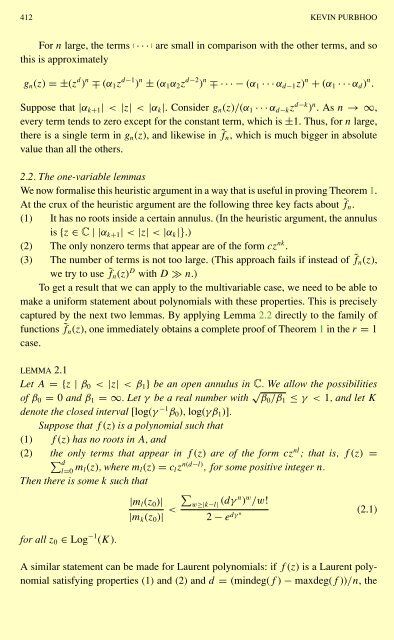- Page 1 and 2: A NULLSTELLENSATZ FOR AMOEBAS KEVIN
- Page 3 and 4: A NULLSTELLENSATZ FOR AMOEBAS 409
- Page 5: A NULLSTELLENSATZ FOR AMOEBAS 411 A
- Page 9 and 10: A NULLSTELLENSATZ FOR AMOEBAS 415 I
- Page 11 and 12: A NULLSTELLENSATZ FOR AMOEBAS 417
- Page 13 and 14: A NULLSTELLENSATZ FOR AMOEBAS 419 C
- Page 15 and 16: A NULLSTELLENSATZ FOR AMOEBAS 421 f
- Page 17 and 18: A NULLSTELLENSATZ FOR AMOEBAS 423 a
- Page 19 and 20: A NULLSTELLENSATZ FOR AMOEBAS 425 N
- Page 21 and 22: A NULLSTELLENSATZ FOR AMOEBAS 427
- Page 23 and 24: A NULLSTELLENSATZ FOR AMOEBAS 429 4
- Page 25 and 26: A NULLSTELLENSATZ FOR AMOEBAS 431 O
- Page 27 and 28: A NULLSTELLENSATZ FOR AMOEBAS 433 g
- Page 29 and 30: A NULLSTELLENSATZ FOR AMOEBAS 435 z
- Page 31 and 32: A NULLSTELLENSATZ FOR AMOEBAS 437 P
- Page 33 and 34: A NULLSTELLENSATZ FOR AMOEBAS 439 a
- Page 35 and 36: A NULLSTELLENSATZ FOR AMOEBAS 441 a
- Page 37 and 38: A NULLSTELLENSATZ FOR AMOEBAS 443 C
- Page 39 and 40: A NULLSTELLENSATZ FOR AMOEBAS 445 R
- Page 41 and 42: 448 DAVID GINZBURG The method we us
- Page 43 and 44: 450 DAVID GINZBURG Let ν denote a
- Page 45 and 46: 452 DAVID GINZBURG Proof The proof
- Page 47 and 48: 454 DAVID GINZBURG correspond to th
- Page 49 and 50: 456 DAVID GINZBURG Next, consider t
- Page 51 and 52: 458 DAVID GINZBURG To state the fol
- Page 53 and 54: 460 DAVID GINZBURG check that up to
- Page 55 and 56: 462 DAVID GINZBURG where L τ (¯s)
- Page 57 and 58:
464 DAVID GINZBURG To define the li
- Page 59 and 60:
466 DAVID GINZBURG cuspidality of t
- Page 61 and 62:
468 DAVID GINZBURG immediately foll
- Page 63 and 64:
470 DAVID GINZBURG expansion. Here
- Page 65 and 66:
472 DAVID GINZBURG Notice that S l
- Page 67 and 68:
474 DAVID GINZBURG values of m ′
- Page 69 and 70:
476 DAVID GINZBURG For 1 ≤ i ≤
- Page 71 and 72:
478 DAVID GINZBURG 2m rows, we have
- Page 73 and 74:
480 DAVID GINZBURG left to right. C
- Page 75 and 76:
482 DAVID GINZBURG unipotent orbit
- Page 77 and 78:
484 DAVID GINZBURG for every choice
- Page 79 and 80:
486 DAVID GINZBURG is equal to L(σ
- Page 81 and 82:
488 DAVID GINZBURG Here f π (h) is
- Page 83 and 84:
490 DAVID GINZBURG character ψ Um
- Page 85 and 86:
492 DAVID GINZBURG Proof The proof
- Page 87 and 88:
494 DAVID GINZBURG in the above ref
- Page 89 and 90:
496 DAVID GINZBURG THEOREM 7 The ir
- Page 91 and 92:
498 DAVID GINZBURG In the above, th
- Page 93 and 94:
500 DAVID GINZBURG is GL 2m+1 × SO
- Page 95 and 96:
502 DAVID GINZBURG [GP] S. GELBART
- Page 97 and 98:
A CHARACTERIZATION OF SUBSPACES AND
- Page 99 and 100:
A CHARACTERIZATION OF SUBSPACES AND
- Page 101 and 102:
A CHARACTERIZATION OF SUBSPACES AND
- Page 103 and 104:
A CHARACTERIZATION OF SUBSPACES AND
- Page 105 and 106:
A CHARACTERIZATION OF SUBSPACES AND
- Page 107 and 108:
A CHARACTERIZATION OF SUBSPACES AND
- Page 109 and 110:
A CHARACTERIZATION OF SUBSPACES AND
- Page 111 and 112:
DEGREE GROWTH OF MEROMORPHIC SURFAC
- Page 113 and 114:
DEGREE GROWTH OF MEROMORPHIC SURFAC
- Page 115 and 116:
DEGREE GROWTH OF MEROMORPHIC SURFAC
- Page 117 and 118:
DEGREE GROWTH OF MEROMORPHIC SURFAC
- Page 119 and 120:
DEGREE GROWTH OF MEROMORPHIC SURFAC
- Page 121 and 122:
DEGREE GROWTH OF MEROMORPHIC SURFAC
- Page 123 and 124:
DEGREE GROWTH OF MEROMORPHIC SURFAC
- Page 125 and 126:
DEGREE GROWTH OF MEROMORPHIC SURFAC
- Page 127 and 128:
DEGREE GROWTH OF MEROMORPHIC SURFAC
- Page 129 and 130:
DEGREE GROWTH OF MEROMORPHIC SURFAC
- Page 131 and 132:
DISTORTION OF HAUSDORFF MEASURES AN
- Page 133 and 134:
DISTORTION OF HAUSDORFF MEASURES AN
- Page 135 and 136:
DISTORTION OF HAUSDORFF MEASURES AN
- Page 137 and 138:
DISTORTION OF HAUSDORFF MEASURES AN
- Page 139 and 140:
DISTORTION OF HAUSDORFF MEASURES AN
- Page 141 and 142:
DISTORTION OF HAUSDORFF MEASURES AN
- Page 143 and 144:
DISTORTION OF HAUSDORFF MEASURES AN
- Page 145 and 146:
DISTORTION OF HAUSDORFF MEASURES AN
- Page 147 and 148:
DISTORTION OF HAUSDORFF MEASURES AN
- Page 149 and 150:
DISTORTION OF HAUSDORFF MEASURES AN
- Page 151 and 152:
DISTORTION OF HAUSDORFF MEASURES AN
- Page 153 and 154:
DISTORTION OF HAUSDORFF MEASURES AN
- Page 155 and 156:
DISTORTION OF HAUSDORFF MEASURES AN
- Page 157 and 158:
DISTORTION OF HAUSDORFF MEASURES AN
- Page 159 and 160:
DISTORTION OF HAUSDORFF MEASURES AN
- Page 161 and 162:
DISTORTION OF HAUSDORFF MEASURES AN
- Page 163 and 164:
DISTORTION OF HAUSDORFF MEASURES AN
- Page 165 and 166:
574 MARCHÉ and NARIMANNEJAD them w
- Page 167 and 168:
576 MARCHÉ and NARIMANNEJAD 1.1. P
- Page 169 and 170:
578 MARCHÉ and NARIMANNEJAD 2.1. T
- Page 171 and 172:
580 MARCHÉ and NARIMANNEJAD Figure
- Page 173 and 174:
582 MARCHÉ and NARIMANNEJAD Figure
- Page 175 and 176:
584 MARCHÉ and NARIMANNEJAD Defini
- Page 177 and 178:
586 MARCHÉ and NARIMANNEJAD [A2] [
















